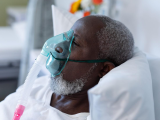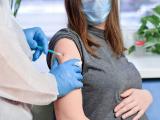Facing an onslaught of Omicron variant activity amid holiday gatherings and travel, the Centers for Disease Control and Prevention (CDC) yesterday updated its COVID-19 guidance yesterday, halving the isolation and quarantine period for people with or exposed to the coronavirus.
The move, which relies on masking and accounts for sparse rapid test availability, drew praise from some experts as a needed change in the face of an evolving situation. But it also drew sharp criticism from other experts and some labor officials, who point to scientific gaps and ongoing risks.
CDC anticipates major Omicron-driven disruptions
In a press release announcing the new recommendations yesterday, the CDC recommended that anyone who tests positive, regardless of vaccination status, stay home for 5 days. If there are no symptoms or symptoms resolve after 5 days, the individual can leave the house if they mask around others for 5 days.
For those who are exposed, the CDC recommends people who aren't boosted or are unvaccinated should stay home for 5 days, then wear a mask around others for 5 more days. Those who are boosted or recently completed their primary vaccination series should mask around others for 10 days. Both groups should test on day 5, if possible.
CDC Director Rochelle Walensky, MD, MPH, said the quickly spreading Omicron variant has the potential to impact all parts of society. She added that the new guidance takes into account what's known about virus spread and protection from vaccines and boosters.
"These updates ensure people can safely continue their daily lives. Prevention is our best option: get vaccinated, get boosted, wear a mask in public indoor settings in areas of substantial and high community transmission, and take a test before you gather," she said.
Leana Wen, MD, former Baltimore health commissioner and contributing columnist for the Washington Post, said on Twitter that the CDC's decision to reduce isolation and quarantine was needed to prevent the collapse of critical infrastructure, with the nation poised to pass its previous COVID-19 peak, possibly reaching 1 million cases a day.
Ashish Jha, MD, MPH, dean of the Brown University School of Health, on Twitter today said the new guidance is a step in the right direction, taking into account the period when people are most contagious, while minimizing unnecessary constraints and encouraging more people to test and isolate.
However, other experts said the 5-day isolation period unpaired with a negative test is risky and not supported by data.
Michael Mina, MD, PhD, epidemiologist and major proponent of at-home COVID-19 antigen tests, on Twitter said the new guidance is reckless and noted that some people are infectious for 3 days, while others can still pass the virus at 12 days. He said testing negative to leave isolation early is a smart strategy, as would be wearing an N95 mask if leaving isolation.
Mina said the lack of a negative test requirement before leaving isolation probably reflects a perception that there aren't enough rapid tests in the United States, which he said is a massive problem that can be easily changed.
Meanwhile, the Association of Flight Attendants today questioned the CDC's new policy, saying it aligns with the number of days pushed by corporations. The group's president, Sara Nelson, called it "less than reassuring."
"If any business pressures a worker to return to work before they feel better we will make clear it is an unsafe work environment, which will cause a much greater disruption than any 'staffing shortages'," she said in a statement.
More COVID headlines
- COVID-19 infections in US children are up 50% since the first of the month, with 199,000 cases in kids reported the week between Dec 16 and Dec 23, the American Academy of Pediatrics said in its latest update. Yesterday, New York officials said COVID-19 hospitalizations in children in New York City have jumped by nearly five times this month.
- The United States reported 512,553 new COVID-19 cases yesterday, and 1,762 deaths, according to the Johns Hopkins COVID-19 tracker. The 14-day average of new daily cases is 243,099, with 1,205 deaths and 71,381 hospitalized, according to the New York Times analysis.
- CDC sequencing data indicates Omicron now accounts for 58.6% of the coronavirus variants circulating around the country.
- In global developments, South African researchers yesterday in a preprint study suggested infection with Omicron boosts immunity against Delta. Also, an analysis of 53 seroprevalence studies from India said SARS-CoV-2 prevalence in the country jumped from 20.9% after the country's first wave to 69.2% after its massive Delta wave.
- Australia recorded another record surge in new COVID-19 cases, driven by the highly infectious Omicron variant, Reuters Rising cases have prompted the country's state leaders to bring back some containment measures, such as mandatory masking and QR code check-ins at public venues.





















